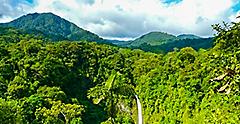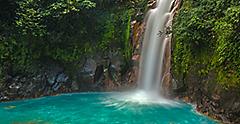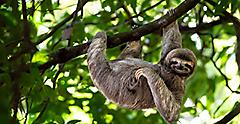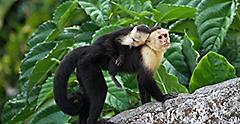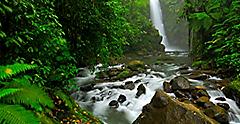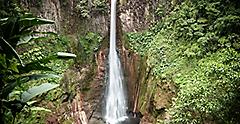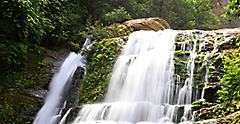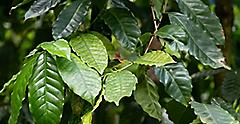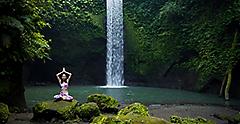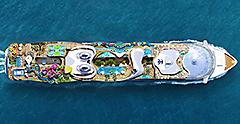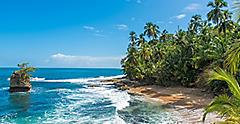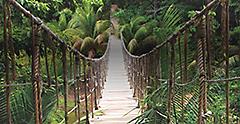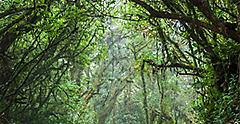By Chantae Reden | Published on April 14, 2023
Wandering to the best waterfalls in Costa Rica is a delight for the senses. Listen to the roar of water soaring into a pool of teal below, feel cool vapor blow against your skin, search for rainbows as sunlight catches the cascades, and witness a vibrancy rivaled only by the plumage of quetzals, toucans and macaws perched in the rainforest canopy.
As a country cloaked in forest (over 25% of which is protected), Costa Rica is home to many of Central America's most spectacular waterfalls. If you're interested in getting misted, you won't want to miss these magical waterfalls when you cruise to Costa Rica.
See Costa Rica's Best Waterfalls
Hidden in a biological reserve on the foothills of Arenal Volcano and standing at 246 feet high, La Fortuna Waterfall is one of the most beautiful sights in Costa Rica. The waterfall trailhead begins 10 minutes outside the town of La Fortuna, and your journey starts with a parrot's-eye-view of the waterfall from an observation platform. Use this part of the trail to search for birds like wrens, woodpeckers, tanagers, parrots, honeycreepers and toucans who flit about the treetops. You'll also find a restaurant, gift shop and restroom near the observation platform.
There are around 450 steps along the path to the base of the La Fortuna Waterfall, and the view is worth each one with a pair of sturdy shoes underfoot. Benches along the way provide a scenic place to rest and soak in the scenery. Once you reach the trail's end, a pool of brisk water awaits for a refreshing swim. Many travelers prefer to take a dip a little further from the waterfall in a tranquil pool ideal for wading. For a full day of adventure, combine your trip to the waterfall with a kayak down the Arenal River or around Lake Arenal, walk amid the treetops on a hanging bridge tour or search for tiny waterfalls along the trails near the town of La Fortuna.
Your next stop on your Costa Rica waterfall tour is to Rio Celeste Waterfall. Photographers have often been accused of altering the color of the water of the Rio Celeste Waterfall to make it seem bluer and brighter than it is. However, if you visit for yourself, you'll see that the colors of the river truly are as vivid in person as they are online. Local legend states that the powder blue waters of the Rio Celeste were formed when a god swirled his paintbrush in the river after painting the sky its signature hue. Unsatisfied with this explanation, researchers from the University of Costa Rica sought to answer what gives the river its distinguishing color. As soon as they placed some of the water in test tubes, the bright blue water turned transparent. Eventually, they discovered the color was caused by minerals, called aluminosilicate, reflecting sunshine. This creates an optical illusion, turning transparent waters bright blue to the camera lens and human eye. This is one of the best places to visit in Costa Rica for photographers.
By car, Rio Celeste Waterfall in Tenorio Volcano National Park is a little over two and a half hours away from the port town of Puntarenas. The hike from the trailhead to the waterfall is about a mile long, mostly along a dirt trail with around 250 steep steps. Wear hiking sandals or closed-toe shoes just in case the trail is muddy. Look for monkeys, frogs, birds and tapirs hiding in the greenery along the trail. Then, stop at the top of the staircase leading to the pool of Rio Celeste Waterfall for an iconic photo of the fall. For more fun in Tenorio Volcano National Park, tiptoe across a series of canopy suspension bridges, search for tapir tracks around Lago Danta and unwind in steamy hot springs.
Caribbean cruises to Costa Rica often stop in the tranquil town of Puerto Limon, just an hour away by car from the cloud-topped beauty of Veragua Rainforest. This rainforest reserve is rife with wildlife, where sloths embrace the on-vacation lifestyle by lazing the day away on tree branches. Butterflies, monkeys, bats, frogs, snakes and over 400 species of birds add a pop of color against the forest's greenery. If you keep a sharp eye out, you might be able to see the rainforest's more camouflaged critters, such as green tree frogs, along the reserve's well-kept trails.
Where To Visit In Costa Rica?
"Paz" means "peace" in Spanish, and you'll find a relaxing experience at La Paz Waterfall Gardens, a little over an hour north of San Jose by car. This rejuvenating nature park has five waterfalls within its grounds, ranging from tall bridal veils to wide roaring cascades. Spend a day wandering along the trails from waterfall to waterfall in search of spider monkeys, white faced monkeys, jaguars, pumas, sloths, birds, frogs, snakes and other wild animals. Two miles of well-maintained walking trails lead to the waterfalls with lookout points throughout. For the best views, head to the top of Templo Waterfall, a waterfall tucked in between a forest of large ferns.
Aside from waterfalls galore, the private nature reserve hosts an aviary, butterfly garden, frog exhibit and serpentarium. There's also a jungle cat exhibit — a refuge for big cats such as pumas, ocelots and jaguars rescued from the illegal pet trade industry.
Which Waterfalls You Can Swim In?
Only an hour south of Puerto Limon are some of Costa Rica's most underrated cascades. Combine a trip to the beach with a stop at an inland waterfall for one of the most adventurous ways to enjoy Costa Rica's Caribbean coast. This region is home to the Bribri people, one of Costa Rica's indigenous communities, and guides from the Bribri village will lead you to the hard-to-find Volio Waterfall, a 50-foot cascade near cacao plantations. Another spectacular waterfall (that's a bit easier to find) is the Catarata Ma-Cu Waterfall, the largest in the region and a one of the best waterfalls you can swim and relax in for a few hours. Catarata Ma-Cu Waterfall is about a 10-minute walk along a steep trail from the trailhead. Don't miss the bright red tree frogs that sunbathe on the rocks near the base of the falls!
Journey to just outside the town of Bajos del Toro to see one of the most dramatic waterfalls in Costa Rica. The Catarata del Toro plummets nearly 300 feet off the cliff of a volcanic caldera. From the entrance of the trail, admire the bird's-eye-view of whitewater as it crashes into an azure pool surrounded by carpets of emerald green moss. A restaurant and hummingbird garden offer a nice place to rest before or after you trek 200 steps to the base of the waterfall. Because of its size and power, swimming is not allowed in the pool of the waterfall, but its spray will keep you cool as you trek along the trail.
The aptly named Blue Falls are twin waterfalls found within the same private preserve as Del Toro Waterfall. Like Rio Celeste Waterfall, the pools at the base of each cascade have a unique blue hue found few places else in the world. Fortunately, the twin falls are rarely crowded, and it's possible to beat the crowds here nearly all year long. The trail to Blue Falls errs on the adventurous side with stream crossings and a few scramble sections. Going with a guide is recommended.
Travel Tips For Seeing The Best Costa Rican Waterfalls
It'd be easy to base your Costa Rica vacations solely around seeing the country's best waterfalls. While many waterfalls are easily accessible, others are only found at the bottom of a steep trail. Here are a few tips to make the most of your Costa Rica waterfall wander.
Consider When Is The Best Time To Visit Costa Rica
The best time to visit Costa Rica waterfalls is the start of Costa Rica's dry season, from December to April. When waterfalls get too much rain, the trails leading to them are often bogged with mud. Too much water flowing into a pool can cause the pool to turn murky or create currents too strong to swim. Lighter flows are better for swimming, while stronger flows are ideal for photographing.
Costa Rica Travel Wardrobe, Dress Accordingly
Most of the best waterfalls in Costa Rica are found deep in its cloud rainforests, where humidity trapped under the tree canopy provides life to its wonderful flora. Wear sturdy hiking sandals or closed-toed shoes to navigate slippery steps, tree roots and rocks. A downpour the night before can make trails slick and muddy the next day. Pack a hiking stick if you'd like, as well as your own water. A rain jacket will keep you dry once you get closer to the waterfall — it's bound to be a misty experience, after all. Pack any valuables and snacks in a dry bag to keep it protected, and don't forget binoculars if you'd like to stop and search for wildlife.
How To Photograph Waterfalls, Fine-Tuning Your Camera Settings
Get Royal Deals, Sign Up Today

Getting There
Explore Our Most Affordable Itineraries
Discover waterfalls galore and more on a Royal Caribbean South America cruise.

